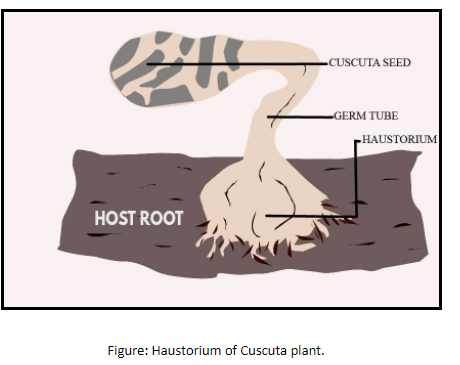
Haustorial root is present in
(a)Zea Mays
(b)Cactus
(c)Cuscuta
(d)Monotropa
Answer
487.2k+ views
Hint: Haustoria is the portion of the root apex in the parasitic plant or parasitic fungus that helps to penetrate the host's tissues for getting the necessary nutrients for the growth of the parasitic plant.
Complete answer:
Cuscuta is a parasitic plant because its leaves are reduced, so least photosynthesis occurs within this plant. Hence, it has to depend on other plants for its survival. After it attaches itself to a plant, it wraps itself around it. If the host has food beneficial to this plant, it produces haustoria that inserts itself into the vascular system of the host. The original root of the Cuscuta then dies in the soil. The dodder can grow and attach itself to a number of plants.

Additional Information: -Cuscuta is also known as the dodder plant.
-Cuscuta is the total stem parasitic.
-Cuscuta plant is an ectoparasite that lives on the outside of the host.
-Dodder is found on a vast variety of plants, including several agricultural and horticultural crop species, such as alfalfa, lespedeza, flax, clover, potatoes, chrysanthemum, dahlia, helenium, trumpet vine, ivy, and petunias.
-Zea mays are the maize, cactus is the xerophyte and Monotropa is a flowering plant, and its roots have a mycorrhizal association and lack haustoria.
So, the correct answer is, ‘Cuscuta.’
Note: In tropical areas, with a hot humid climate, it can grow more or less continuously and may reach high into the canopy of shrubs and trees; in cold temperate regions, it is an annual plant and is restricted to low vegetation that can be reached by new seedlings.
Complete answer:
Cuscuta is a parasitic plant because its leaves are reduced, so least photosynthesis occurs within this plant. Hence, it has to depend on other plants for its survival. After it attaches itself to a plant, it wraps itself around it. If the host has food beneficial to this plant, it produces haustoria that inserts itself into the vascular system of the host. The original root of the Cuscuta then dies in the soil. The dodder can grow and attach itself to a number of plants.

Additional Information: -Cuscuta is also known as the dodder plant.
-Cuscuta is the total stem parasitic.
-Cuscuta plant is an ectoparasite that lives on the outside of the host.
-Dodder is found on a vast variety of plants, including several agricultural and horticultural crop species, such as alfalfa, lespedeza, flax, clover, potatoes, chrysanthemum, dahlia, helenium, trumpet vine, ivy, and petunias.
-Zea mays are the maize, cactus is the xerophyte and Monotropa is a flowering plant, and its roots have a mycorrhizal association and lack haustoria.
So, the correct answer is, ‘Cuscuta.’
Note: In tropical areas, with a hot humid climate, it can grow more or less continuously and may reach high into the canopy of shrubs and trees; in cold temperate regions, it is an annual plant and is restricted to low vegetation that can be reached by new seedlings.
Recently Updated Pages
Master Class 9 General Knowledge: Engaging Questions & Answers for Success

Master Class 9 English: Engaging Questions & Answers for Success

Master Class 9 Science: Engaging Questions & Answers for Success

Master Class 9 Social Science: Engaging Questions & Answers for Success

Master Class 9 Maths: Engaging Questions & Answers for Success

Class 9 Question and Answer - Your Ultimate Solutions Guide

Trending doubts
According to Bernoullis equation the expression which class 11 physics CBSE

A solution of a substance X is used for white washing class 11 chemistry CBSE

10 examples of friction in our daily life

Simon Commission came to India in A 1927 B 1928 C 1929 class 11 social science CBSE

Difference Between Prokaryotic Cells and Eukaryotic Cells

Can anyone list 10 advantages and disadvantages of friction




